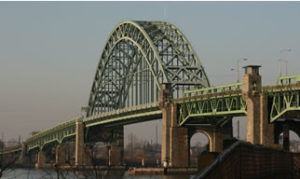
Drexel University engineering student Jeffrey Dowgala says real-time information recorded by electronic sensors has helped him and his classmates understand the many environmental factors that can affect a bridge—an impact impossible to explore in standard textbooks.
Philadelphia-based Drexel and prominent engineering programs at Northeastern University in Boston, Purdue University, and Texas A&M University secured $200,000 from the National Science Foundation last year to use monitoring equipment that shows how a nearby bridge reacts to traffic, heavy vehicles, and weather.
Information collected from each sensor will be streamed to university classrooms, where students and faculty members will analyze how the bridge handles its daily carloads.
“This allows students to see how a structure really behaves, instead of the idealistic ways bridges are supposed to behave when you are in the classroom,” said Dowgala, a Drexel senior. “We can see all the different factors that affect how the bridge behaves, rather than the simplistic forms studied in classroom.”
More than 100 sensors were installed on the 500-foot Tacony-Palmyra Bridge, which connects Palmyra, N.J., to northern Philadelphia. Engineering students will study the structure’s three main parts: the arch, the main span, and the draw bridge span.
Franklin Moon, assistant professor of civil engineering at Drexel’s College of Engineering, said even the most explanatory textbook diagrams can’t teach students what they learn by observing minute-by-minute data from an 80-year-old bridge that has 50,000 vehicles drive across it every day.
“The goal was to somehow show students the reality of what structures are,” Moon said. “Too often you go into a standard textbook and find line drawings, a beam, and columns. The students don’t understand the context of what they’re seeing.”
Engineering students at Drexel also will study social aspects of the monitored Tacony-Palmyra Bridge.
Curriculum will include sections on the history of the bridge, its environmental impact, and which populations use it most, according to Drexel’s web site. Studying the history of the bridge and its local population, Dowgala said, has given engineering students a more in-depth look at the structure and its effect on the local environment.
“You realize just how much there is to learn about it,” he said.
Studying the Tacony-Palmyra Bridge with the help of technology, Moon said, “really grabs the attention” of first-year students. Having access to information collected by the bridge sensors also has helped Moon hone his daily lectures.
“If I can’t teach something using the sensors, I have to ask myself if that lesson is relevant,” he said. “I know that … students are smart enough to know that a few lines on a piece of paper is not a real structure.”
Other students and researchers have used environmental sensors for educational purposes in recent years. In 2007, researchers from Clarkson University in Potsdam, N.Y., developed and installed electronic sensors powered by vibrations from passing cars and trucks.
Clarkson officials hoped to avoid replacing pricey batteries in each sensor, so they used energy created by passing traffic to maintain the electrical charge. The sensors monitor traffic patterns and the strength of a bridge located on New York State Route 11.
Keeping an electronic eye on bridges could warn authorities before aging structures become unsteady and dangerous.
Thirteen people died and more than 140 were injured when a Minneapolis bridge built over the Mississippi River collapsed during rush hour on Aug. 1, 2007. Officials said design flaws caused the 40-year-old structure to give way.
About 25 percent of America’s nearly 600,000 bridges are classified as deficient or “functionally obsolete,” according to Federal Highway Administration statistics.
Dowgala said the long-term impact of sunlight is a factor students can’t study in an hour-long lecture or from a textbook excerpt. If the sun shines on one side of the bridge, he said, that side will expand over time.
“It’s not going to make it fail, but it is an interesting aspect,” Dowgala said.
Moon said Drexel University faculty members are working with local officials in charge of the Tacony-Palmyra Bridge to make the streaming sensor information available to any student with a laptop. The information feed is currently available through the engineering program.
The real-time feed would be password-protected, Moon said, so that only students and professors could access the constantly-changing readout.
“If this is going to be successful, students are going to have to have direct access,” he said.
Links:
Drexel University College of Engineering
- Research: Social media has negative impact on academic performance - April 2, 2020
- Number 1: Social media has negative impact on academic performance - December 31, 2014
- 6 reasons campus networks must change - September 30, 2014

